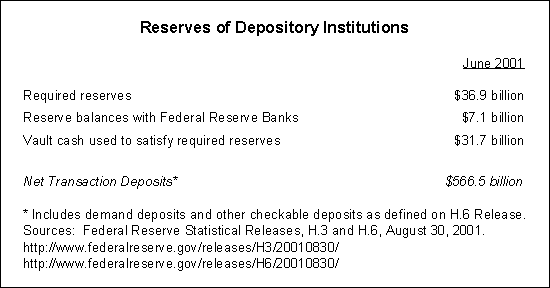Reserve requirements are one of the three monetary policy tools the Federal Reserve uses to implement monetary policy. However, in recent years the Fed has seldom employed changes in reserve requirements to enact monetary policy, because open market operations are a much more precise tool.1
What Are Reserve Requirements?
Banks and other depository institutions (savings institutions, credit unions, and foreign banking entities) are required to hold a portion of their deposits as reserves. Depository institutions may hold reserves either as vault cash or as deposits with Federal Reserve Banks.2 Effective December 28, 2000, depository institutions were required to hold a reserve requirement of 3 percent against their first $42.8 million in net transaction accounts (demand and other checkable deposits) and 10 percent against their net transaction accounts above $42.8 million.3 At present, there is no reserve requirement on time and savings deposits. The table shows that aggregate required reserves of depository institutions were $36.9 billion as of June 2001, according to the Federal Reserve Board’s H.3 Statistical Release.

Reserve Requirement Changes Affect the Money Stock
Purpose and Functions (1994) describes how a change in the reserve requirement ratio affects bank credit and the money stock.4 Reserve requirements are the percentage of deposits that depository institutions must hold in reserve and not lend out. For example, with a 10 percent reserve requirement on net transaction accounts, a bank that experiences a net increase of $200 million in these deposits would be required to increase its required reserves by $20 million. The bank would be able to lend the remaining $180 million of deposits, resulting in an increase in bank credit. As those funds are lent, they create additional deposits in the banking system. The increase in deposits affects the money stock, because it is measured in several ways that primarily include various categories of deposits and currency in the hands of the public.5
- Increasing the (reserve requirement) ratios reduces the volume of deposits that can be supported by a given level of reserves and, in the absence of other actions, reduces the money stock and raises the cost of credit.
- Decreasing the ratios leaves depositories initially with excess reserves, which can induce an expansion of bank credit and deposit levels and a decline in interest rates.
The volume of net transaction deposits held by all depository institutions is large, $566.5 billion, as of June 2001 (see table and H.6 Release). Thus, even a small change in the reserve requirement ratio may have a relatively large effect on reserve requirements and the money stock.
Few Changes in Reserve Requirements
There are several reasons why reserve requirements are not frequently changed, the most important of which is that open market operations provide a much more precise tool for implementing monetary policy. When the Fed purchases $10 billion in securities for its own portfolio, it adds $10 billion to bank reserves.
The impact of changes in reserve requirements is difficult to estimate; each change has the potential to affect thousands of depository institutions in different ways, depending on each institution’s deposit base. Changes in reserve requirements also typically lead to changes in pricing schedules for some bank services, because some bank fees and credits are set based on reserve requirements.
Endnotes
1. The third monetary policy tool is the discount rate, the interest rate charged when depository institutions borrow overnight from the Federal Reserve discount window.
2. The Monetary Control Act of 1980 sets the statutory requirements for reserves.
3. Net transaction accounts include checking accounts (demand deposits), NOW accounts, and share drafts.
4. Purposes & Functions (1994), The Federal Reserve System, Washington, DC, page 57. In a fractional reserve system, banks are only required to hold reserves against a fraction of their deposits.
5. Three standard measures of the money stock are M1 (currency, travelers’ checks, net demand deposits, and other checkable deposits), M2 (M1 plus savings deposits, small-denomination (under $100,000) time deposits, and balances in retail money market mutual funds), and M3 (M2 plus large-denomination ($100,000 or more) time deposits, balances in institutional money market mutual funds, repurchase agreement liabilities issued by depository institutions, and Eurodollars held by U.S. residents). For additional detail, see the H.6 Release, Money Stock and Debt Measures, footnotes. http://www.federalreserve.gov/releases/
References
Aggregate Reserves of Depository Institutions and the Monetary Base. H.3 Statistical Release. The Board of Governors of the Federal Reserve System, Washington, DC. http://www.federalreserve.gov/releases/
Federal Reserve Bulletin, The Board of Governors of the Federal Reserve System, Washington, DC. See Financial and Business Statistics. Table 1.15, Reserve Requirements of Depository Institutions, provides current reserve requirements and their effective dates.
Money Stock and Debt Measures. H.6 Statistical Release. The Board of Governors of the Federal Reserve System, Washington, DC. http://www.federalreserve.gov/releases/
Purposes & Functions (1994), The Federal Reserve System, Washington, DC,. 9/14/2001. http://www.federalreserve.gov/pf/pdf/frspf3.pdf
Reserve Requirements, FedPoint Publications, Federal Reserve Bank of New York, New York, 9/14/2001. http://www.ny.frb.org/pihome/fedpoint/fed45.html